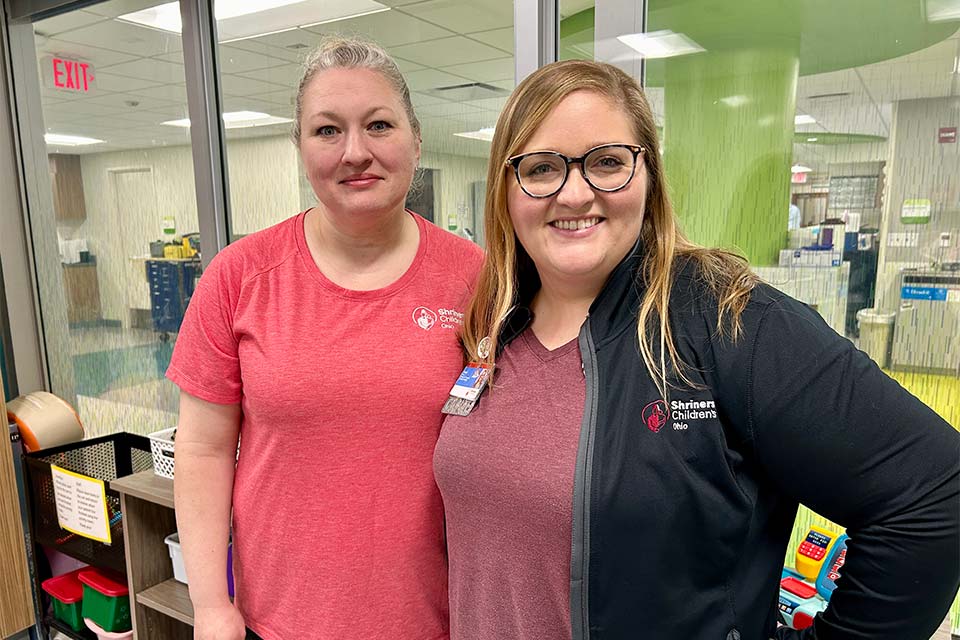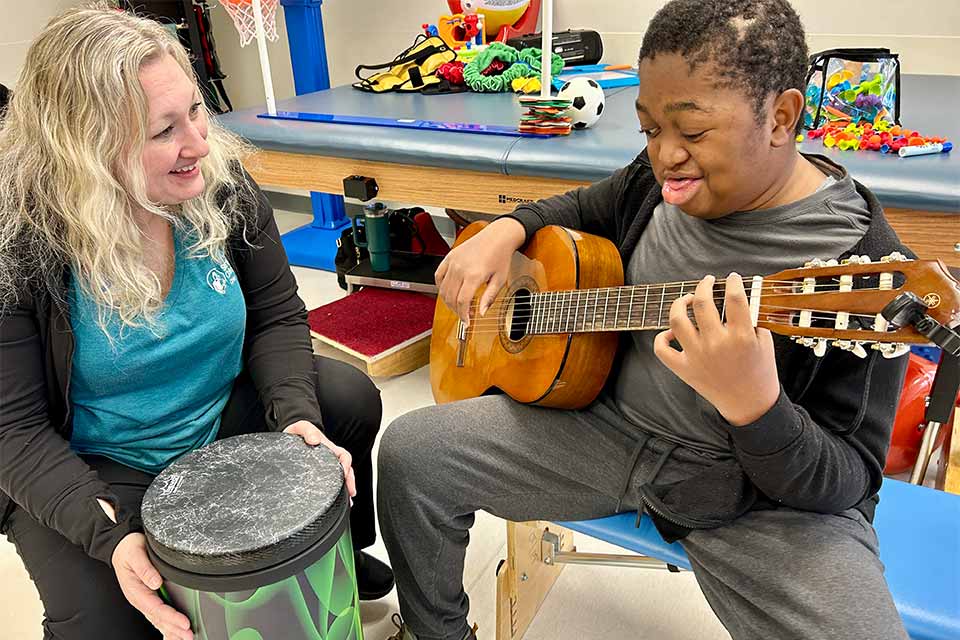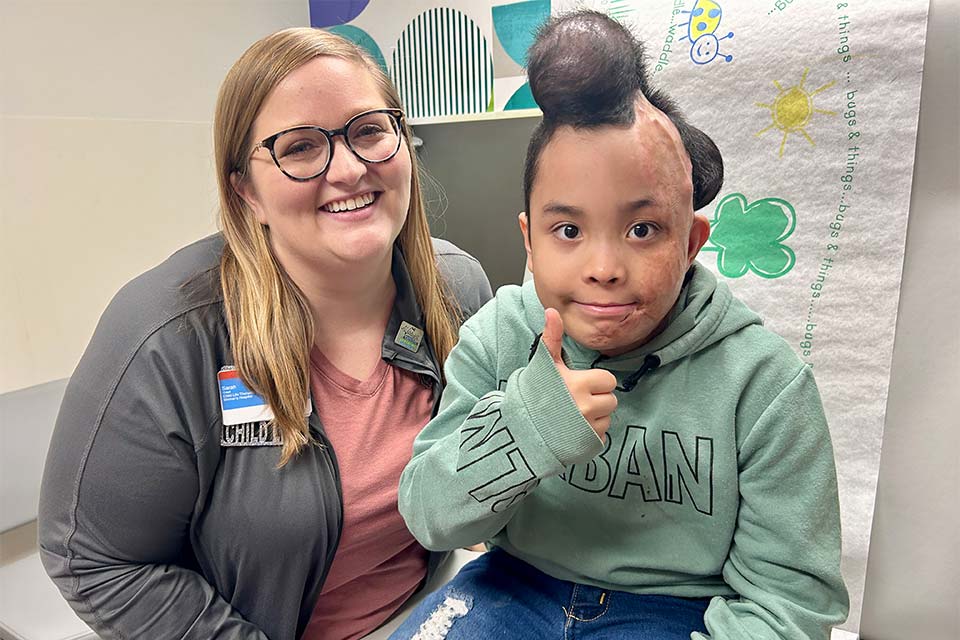A Day in the Life: Shriners Children's Child Life Specialists

Michelle (left) and Sarah (right) are two of the child life specialists at Shriners Children's.
There is no such thing as a typical day for Shriners Children’s certified child life specialists.
Their schedule revolves around the heart of our mission – pediatric patients – and their needs rarely only fall between 8 a.m. and 5 p.m. Michelle Smith and Sarah O’Neal, certified child life specialists at Shriners Children’s Ohio, arrive early in the morning for the first scheduled surgery, and to greet families in the same-day surgery unit.
“We quickly assess the patient and family’s understanding of the surgery and the overall goal for the day,” Smith said. That’s when child life taps into a variety of preparation interventions, such as medical play where the patients can be hands on with medical tools and become the doctor, while a stuffed animal or doll is the patient.
“The interactive experience helps make kids more comfortable and empowers them to help their cuddly ‘patient’ cope with the procedure, which in turn, gives the patient confidence and acts as preparation for what to expect in their own procedure,” O’Neal said.
Child life specialists are also responsible for support in the outpatient clinic and inpatient unit, which at Shriners Children’s Ohio is usually filled with children recovering from an acute burn injury. Smith and O’Neal said, although a hospital stay can be scary for any child, there are unique stressors in a burn unit setting.
“Depending on the severity of the burn, patients undergo multiple daily procedures, like dressing changes, that can last hours,” Smith said. Similar to patients in the same-day surgery unit, child life specialists can be at the bedside to provide distraction and relaxation during dressing changes or needle pokes, and teach patients how to tap into or develop new coping skills.
Additionally, child life specialists meet one-on-one with inpatients and provide kids a safe space to talk about or play through their burn injury or hospital experience.
“We’re trained to meet children where they are,” O’Neal said. “Some kids are on bedrest, can’t leave their room, or are dealing with other limitations, so we will adapt activities to meet their needs, and sometimes even play for them until they can play for themselves.”

Michelle works with MJ in the OT/PT gym.
However, the role of child life specialists at Shriners Children's is deeper than just distraction and coping techniques; they are certified and trained to evaluate a child’s developmental and psychosocial needs. That’s why they are part of the interdisciplinary team. Smith and O’Neal attend regular team meetings such as multidisciplinary rounds, which is when each department provides an update on the patient’s status, including any progress, challenges or areas that need more support.
“Our job is to look at the whole child. This includes how they are coping with why they are in the hospital, all the procedures they are experiencing, and their recovery process," O’Neal said. "Additionally, we support patients and families to help maintain development during treatment, process their injury or illness, and prepare for return to their community.”
If they notice a child is struggling, O’Neal and Smith might introduce different techniques like a goal chart, incentive program or daily schedule that’s customized to the patient. The rest of the clinical team, including nurses, therapists and nutritionists, then work from the same chart or schedule, which creates consistency for both the child and caregivers.
Along with serving patients in same-day surgery and inpatient units, the child life department is a resource for outpatients who need extra support as well. O’Neal and Smith may also be present during a clinic appointment, dressing changes, post-op procedures or difficult exams.
“Most of the burns we treat are small enough that they only need to be seen as an outpatient, but for a child, any hospital visit or exam can be stressful, even scary,” Smith said. With that in mind, each clinic room is stocked with toys, games or other sensory items.
“It’s hard for caregivers to support an upset child while also listening to the nurse or doctor’s assessment and care instructions. We can be there to help the patient relax and provide diversional activities,” O’Neal said. “That helps the parent be more relaxed and able to better focus on the treatment plan."

Sarah helps distract Ricardo during a recent clinic visit.
Their impact goes beyond the walls of the hospital. Even after a child is discharged, the parents or caregivers often still need to do small dressing changes or therapeutic stretches. O’Neal and Smith work with families prior to discharge to educate them about techniques that are effective at calming and empowering their child.
They have both learned to expect the unexpected. In a hospital or clinic setting, the need for patient support can go beyond “normal” business hours. Both O’Neal and Smith acknowledge that their days are unpredictable and can be challenging at times, but working with patients and families validates how important child life services are to the healing process.
"We are able to be right there with them offering care during difficult, and sometimes life-changing, experiences," O'Neal said. "We bolster resiliency and celebrate successes with our patients along the way."
Smith echoed those sentiments. “It’s incredibly powerful and moving to see not only the children’s transformation, but also the ‘ah-ha’ moments from caregivers when they see their child’s emotional and psychosocial needs are being met.”
Keep In Touch
Join our mailing list to stay up to date on everything that's happening at Shriners Children's.
